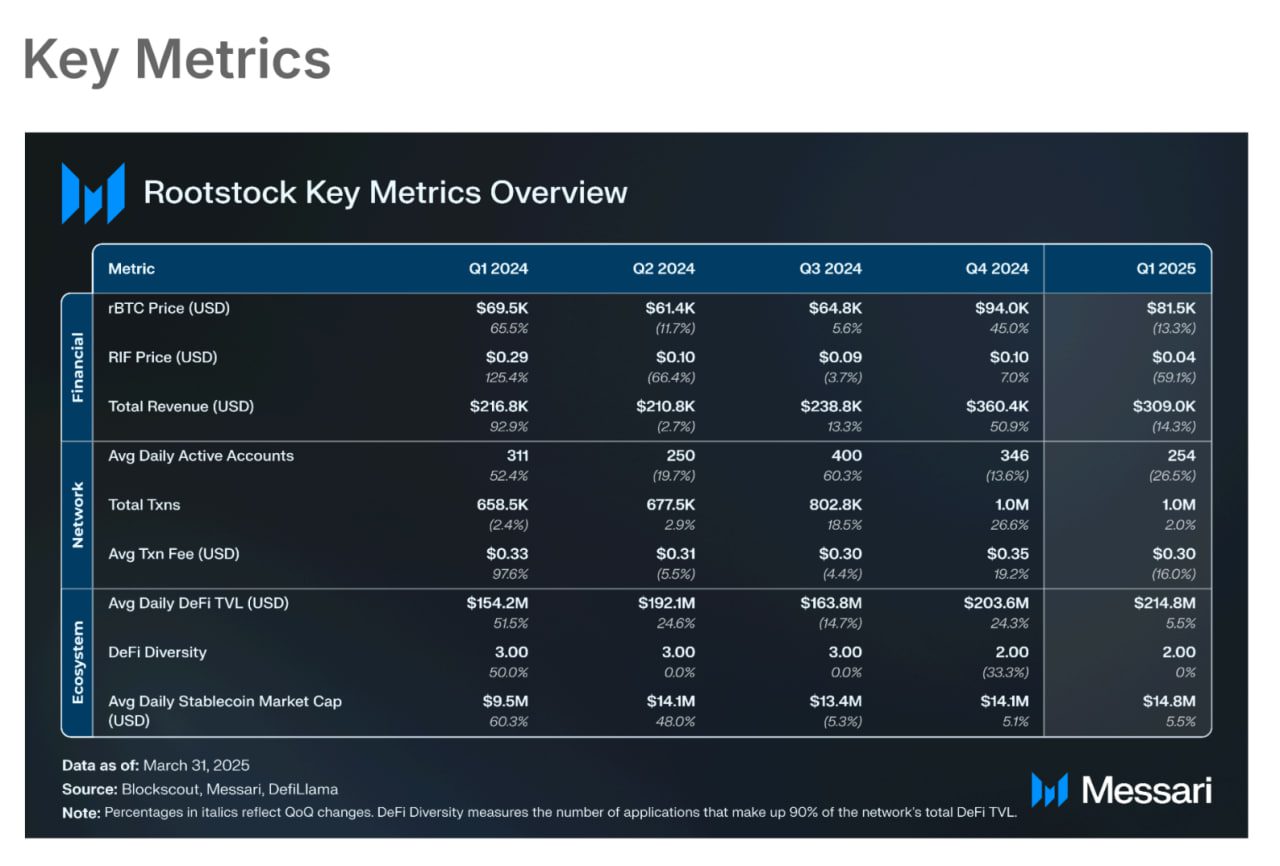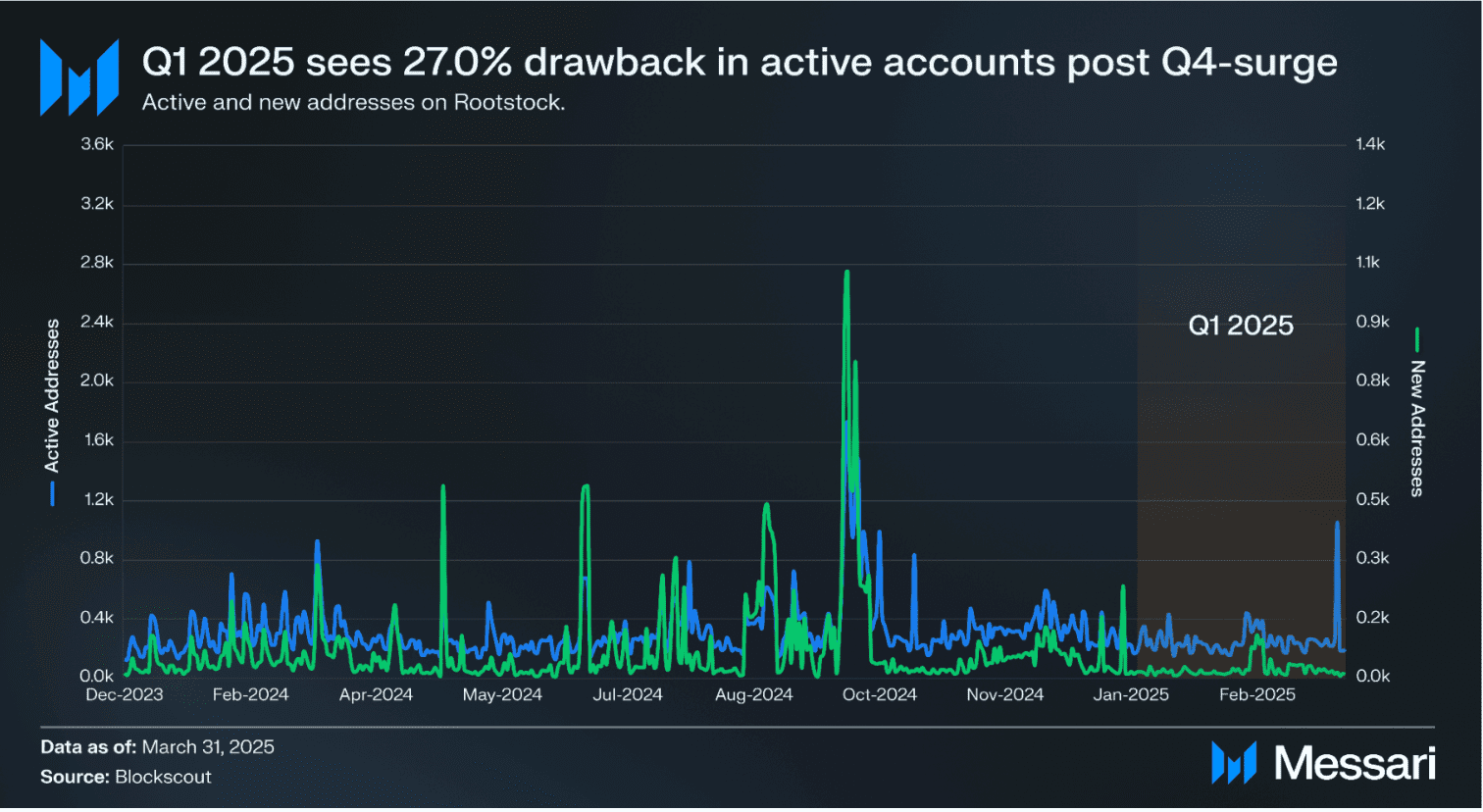Rootstock, a prominent smart contract platform enabling decentralized finance (DeFi) on Bitcoin, experienced a significant boost in network security and mining activity during the first quarter of 2025. This surge occurred even as other metrics, such as Total Value Locked (TVL), experienced a downturn. This report analyzes the factors driving these trends, offering insights into the current state and future prospects of Bitcoin DeFi on Rootstock.
Key Takeaways from Rootstock’s Q1 2025 Performance:
- Mining Participation Surge: Merged mining participation reached a record high of 81%, a substantial increase from 56.4% in Q4 2024. This was largely attributed to the integration of major mining pools like Foundry and SpiderPool.
- Hash Power Boost: The heightened miner interest resulted in Rootstock’s hash power exceeding 740 exahashes per second, surpassing the total Bitcoin network hashrate recorded in October 2024.
- Transaction Fee Reduction: Increased security coincided with a 60% reduction in transaction fees, enhancing the user experience and making Rootstock more competitive.
- TVL Decline: Despite the positive developments in mining, Rootstock’s DeFi ecosystem experienced a decline in TVL. Bitcoin-denominated TVL dropped by 7.2%, and US dollar-denominated TVL fell by 20% quarter-over-quarter to $179.9 million.
- Stablecoin Market Shifts: USDt (USDT) remained the leading stablecoin by value but saw its market share decrease from 41.3% in Q4 2024.
- Mixed User Activity: Active addresses decreased by 26.5%, and new addresses plummeted by 54.7%. However, daily transactions rose slightly by 4.3%, averaging 11,524 per day.
- Development Progress: The platform activated its Lovell 7.0.0 upgrade, enhancing Ethereum Virtual Machine (EVM) compatibility and smart contract performance.
Let’s delve deeper into each of these aspects:
Mining Participation and Network Security
The surge in merged mining participation to 81% is a crucial indicator of Rootstock’s growing security. Merged mining allows Bitcoin miners to simultaneously mine Rootstock’s RBTC token without incurring additional energy costs. By integrating major mining pools like Foundry and SpiderPool, Rootstock has significantly increased its network hashrate and resilience.
“As BTCFi continues to grow, Rootstock is well-positioned for broader adoption through core upgrades like a 60% reduction in transaction fees, alongside sustained investment in builder education and incentive programs,” said Messari analyst Andrew Yang.

Decline in Total Value Locked (TVL)
Despite the advancements in mining and security, Rootstock’s DeFi ecosystem faced challenges in terms of TVL. The 20% drop in US dollar-denominated TVL to $179.9 million indicates a decrease in the value of assets locked within Rootstock’s DeFi protocols. This decline can be attributed to several factors, including broader market trends, increased competition from other DeFi platforms, and potential concerns about the stability and security of specific protocols within the Rootstock ecosystem.
While TVL briefly peaked at $244.6 million in January due to a Bitcoin price rally, it trended downward from March, mirroring a cooling market. Ethereum-based DeFi TVL also experienced a sharp decline in Q1, impacted by macro uncertainty and a significant exploit. This highlights that Rootstock’s TVL decrease wasn’t an isolated incident but part of a broader trend within the DeFi space.
Stablecoin Market Dynamics
The stablecoin market on Rootstock also underwent significant changes. USDt (USDT) remained the dominant stablecoin, holding $3.8 million and a 27.5% market share. However, its dominance decreased significantly from 41.3% in Q4 2024. This suggests a diversification of stablecoin usage within the Rootstock ecosystem, potentially driven by users seeking alternative stablecoins with different risk profiles or features.
By the end of Q1, no single stablecoin commanded over 30% of Rootstock’s stablecoin market, indicating a more fragmented and competitive landscape.
User Activity Trends
User activity on Rootstock presented a mixed picture. While daily transactions increased slightly, active and new addresses experienced significant declines. The 26.5% drop in active addresses and the 54.7% plunge in new addresses suggest a decrease in overall user engagement with the platform. This could be due to factors such as reduced marketing efforts, increased competition from other platforms, or users migrating to other DeFi ecosystems.
Despite the decrease in active and new addresses, the slight increase in daily transactions indicates that existing users are still actively using Rootstock’s protocols. This suggests that Rootstock needs to focus on attracting new users and re-engaging inactive ones to sustain its growth.

Development and Future Outlook
Rootstock continues to make progress on the development front. The activation of the Lovell 7.0.0 upgrade enhances Ethereum Virtual Machine (EVM) compatibility and smart contract performance. This makes it easier for developers to port their existing Ethereum-based dApps to Rootstock and build new ones. Integrations with LayerZero and Meson Finance further expand the ecosystem and improve cross-chain interoperability.
Rootstock’s developer-focused initiatives, including a new hackathon and enhancements to its governance platform, RootstockCollective, demonstrate a commitment to fostering a vibrant and active developer community.
Conclusion
In conclusion, Rootstock’s Q1 2025 performance presents a mixed bag. While the platform experienced a significant boost in mining participation and network security, it also faced challenges in terms of TVL and user activity. The development progress and ongoing initiatives suggest that Rootstock is focused on addressing these challenges and positioning itself for future growth. The key to Rootstock’s long-term success lies in its ability to attract new users, foster a thriving developer community, and continue to innovate and improve its platform.
The Bitcoin DeFi space is still nascent, and Rootstock has the potential to play a significant role in its evolution. By focusing on its strengths and addressing its weaknesses, Rootstock can solidify its position as a leading platform for Bitcoin-based DeFi.